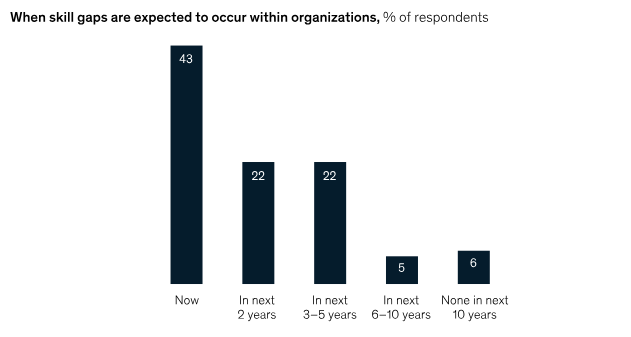Currently, the business world is evolving at a very rapid pace. According to an article published by McKinsey & Company, approximately 87% of companies highlighted that they already have or are likely to have skill gaps within a few years. Therefore, they are in search of additional help.

When it comes to hiring more staff to fill the skill gap, meet a tight deadline, or cater to the talent needs for a specific project, you can opt for two major approaches, i.e., staff augmentation or consulting.
No doubt, both options are valid when your business requires external help to achieve a set goal. However, each of the approaches comes with unique benefits and drawbacks.
To make sure you have maximum productivity from the decisions you make, the basis of all the finalizations relies on the demands of your business. Still feeling confused?
Read on to understand staff augmentation vs. consulting, the major differences, and choose the right option for your business.
What is Staff Augmentation?
When it comes to IT staff augmentation vs. consulting, having a basic idea of the two models is essential. IT Staff augmentation refers to the process of hiring external talent temporarily to supplement the existing staff of an organization. This can be a very useful option to fill the skill gaps or meet your short-term project needs.
This approach allows you to boost your workforce and successfully meet urgent needs without making any long-term commitments, as you have direct control over your augmented staff.
Benefits of IT Staff Augmentation
Before you delve into IT staff augmentation vs. consulting, understanding the benefits of each approach is crucial. Delve into the prominent benefits of leveraging staff augmentation.
Access to Specialized Skills
Hiring talent with specific skills for a short-term project can be very time consuming. You will have to go through a lengthy process of recruitment and training, which can be costly for your organization.
However, with staff augmentation, you can easily gain access to specialized skills and ensure better outcomes.
Flexibility
With staff augmentation, it will be a lot easier for you to scale up and down based on your project requirements. As you do not commit to hiring anyone for full-time roles, you can hire more staff or downsize the team size depending on your unique business needs.
Cost-Effective
Hiring full-time employees comes with several costs. Besides salary, you need to set up a dedicated workspace for them and provide them with benefits like health insurance and more. Moreover, you may even have to invest in training them.
When you choose staff augmentations, you need not worry about all such costs. It ensures greater savings in the long run.
Greater Productivity
Hiring experts with specialized knowledge and skills can ensure the completion of the tasks in the best possible way. As a result, you can expect greater productivity of your business and boost revenues.
Better Control
Augmented staff members are an extended part of your existing team, serving the same purpose. So, you have better control over the external experts. Moreover, they need to adhere to the internal work culture and security practices. As a result, the chances of data theft and security breaches are significantly low.
Easy Replacement
The best thing about staff augmentation is that it doesn’t involve any long-term commitments. You have the option to work with them on a trial basis. If they are not an ideal fit for your project or company, you can simply seek a replacement.
Also Read : IT Staff Augmentation Vs. Outsourcing
Drawbacks of Staff Augmentation
While offering many benefits, staff augmentation also has some drawbacks that you should always consider. Below are the tentative cons that cannot be overlooked:
Limited Knowledge Transfer
As this type of recruitment is only for a short period of time, there is not sufficient time for them to share specialized knowledge with your existing team members. However, you can create a process to facilitate effective knowledge transfer and ensure better collaboration between the outsourced staff and the in-house team.
Integration Challenges
Aligning the newly recruited augmented staff with your pre-existing crew can be a little hassle. It is mainly due to the differences in culture, approach to work, work processes, and communication styles. To ensure a smooth integration, establishing clear expectations, overcoming remote work challenges by providing necessary support to the external team members, and setting up effective communication channels are crucial.
What is Consulting?
On the other hand, software development consulting refers to the process of hiring external experts who can provide strategic insights, solutions, and high-level expertise to organizations. Consultants possess specialized knowledge in specific areas, provide guidance to businesses, and enable them to achieve their objectives.
The consultants offer a wide range of services, including process improvement, strategic planning, and implementation of new technologies. The best part is that this service can be opted for for the time period you want. This can vary from a set of months up to many years.
Benefits of Consulting
Selecting the most efficient IT Outsourcing consultant can avail you with endless benefits. Delve into the most prominent ones!
Access to Expertise of Consultants
The consultants usually have vast experience working on similar projects as yours. As a result, they can bring fresh perspectives and expert approaches to your business. They can enable you to make better decisions and help enhance the success of your projects.
Broad Industry Knowledge
The consultants know the ins and outs of your industry. They are well-versed with the ongoing developments. The consultants can provide you with valuable insights and enable you to get an edge in the market.
Increased Efficiency
The consulting agencies help streamline processes, make the most of available resources, and save time. By increasing efficiency, the consultants can enable you to remain ahead in the competitive era.
Also Read : Advantages and Disadvantages of IT Outsourcing
Drawbacks of Consulting
Consulting services can bring several benefits to organizations. However, there are some limitations that you must know. Read on to explore everything in detail!
Higher Costs
When you opt for consulting, you are hiring professionals who are ready to provide comprehensive expertise. Therefore, they are likely to charge more, adding to your expenses. So, hiring consultants might not be an ideal solution if you are on a tight budget.
Greater Dependency on External Expertise
When you choose consulting services, your reliance on external expertise increases. So, after the contract ends, ensuring that the internal team members can implement and maintain the strategies and recommendations of the experts can be a little challenging.
Staff Augmentation Vs. Consulting – Key Difference & Facts
Now that you have a basic idea of staff augmentation vs. consulting, it is time to explore the key differences between the two. Read on to explore the differences in detail!
Focus and Purpose
In the debate of IT staff augmentation vs. consulting, purpose is a key differentiator. Staff augmentation focuses on providing temporary professionals to help organizations with their short-term project needs. The core aim is to fill the potential skill gap quickly and enhance the capabilities of the existing team.
On the other hand, consulting services provide specialized expertise and valuable insights to address the software development challenges, develop strategies, and improve processes. The core aim is to deliver strategic guidance, offer long-term solutions, and support the goals of clients.
Engagement Model and Duration
When it comes to IT staff augmentation vs. consulting, the duration of the project is a key differentiator. Staff augmentation follows a short-term engagement model in which experts are hired by organizations on a temporary basis. The software development time can range from just a few weeks to several months, depending on the unique needs of the business.
Consultants work in close association with the companies to develop and implement strategic initiatives. It usually takes a longer time and the project duration can span from several months to several years.
Also Read : Types of IT Outsourcing Models
Need for Training
Training is another crucial factor you need to consider when discussing staff augmentation vs. consulting. In the case of staff augmentation, training becomes necessary to make the professional familiar with the internal processes and culture of your company.
However, in the case of consulting, the professionals bring their own expertise. So, there isn’t any need to provide them with training. Instead, they are likely to offer training to your internal dedicated development team and help them develop the new, in-demand skills.
Project Control
In the staff augmentation model, businesses have greater control over the teams and the projects. This is because the external professionals integrate with the in-house team and work under the management of the client.
No doubt, the consultants will work in a collaborative manner with your existing team. However, they are likely to lead the projects and initiatives owing to their expertise in the domain. Also, they may manage the key aspects independently.
Communication
When it is about IT staff augmentation vs. consulting, communication is another aspect you must consider. In the case of staff augmentation, you can directly communicate with the temporary staff members. As they become a part of your team, discussing business, tracking progress, and resolving queries in real-time is easy.
However, in consulting services, the consultants may not be available for communication at all times. As they handle several projects simultaneously, the attention they can provide for your task is limited.
Costs
Between staff augmentation vs. consulting, the former proves to be highly cost-effective. It is because you just have to pay the professionals for the hours worked. This model helps you avoid the long-term financial commitments related to hiring an in-house team.
Opting for consulting services can be expensive owing to the high level of expertise and specialized advice offered. Moreover, they are often offered by top-tier firms.
Also Read : IT Consulting Rates for your Business
Outcomes and Deliverables
Outcomes and deliverables are also significant differentiators to factor in when discussing staff augmentation vs. consulting. The main focus of the augmented staff is usually narrower. The deliverables may include completing specific tasks, contributing to ongoing projects, and aligning with objectives.
Consulting services focus on the delivery of actionable plans, strategic reports, and recommendations. The outcomes of the consulting model may include organizational changes, process improvements, and the implementation of new business strategies.
Conclusion
By now, you must have a comprehensive idea about staff augmentation vs. consulting. While deciding between IT staff augmentation vs. consulting may seem tricky, the choice depends on the unique needs, goals, and budgets of organizations. For instance, if you are on a tight budget and looking for cost-effective software solutions, choosing staff augmentation over consulting is a smart move.
Staff augmentation is suitable for businesses that require additional professionals for a specific task. On the other hand, consulting services are an ideal choice for companies that need the guidance of specialists in a particular field.







